Are you looking for a plant that will add a unique style to your home or office? Spider plants are easy to care for and come in many varieties. In this article, we’ll cover 19 different types of spider plants with pictures so you can find the perfect one for you! Read on to learn more about these fascinating plants and their features.

Contents
- 1 Types Of Spider Plants
- 1.1 Bonnie Spider Plant
- 1.2 Airplane Spider Plant
- 1.3 Hawaiian Spider Plant
- 1.4 Fire Flash Spider Plant
- 1.5 Reverse Spider Plant
- 1.6 Green Spider Plant
- 1.7 Ocean Spider Plant
- 1.8 Variegated Spider Plant
- 1.9 Zebra Spider Plant
- 1.10 Variegated Bonnie Spider Plant
- 1.11 Bichetii Grass Spider Plant
- 1.12 Atlantic Spider Plant
- 1.13 Purple Spider Plant
- 1.14 Shamrock Spider Plant
- 1.15 Mandarin Orange Spider Plant
- 1.16 Curly Spider Plant
- 1.17 Chlorophytum Spider Plant
- 1.18 Vittatum Spider Plant
- 1.19 Spider Flower Plant
- 2 Conclusion
Types Of Spider Plants
Bonnie Spider Plant
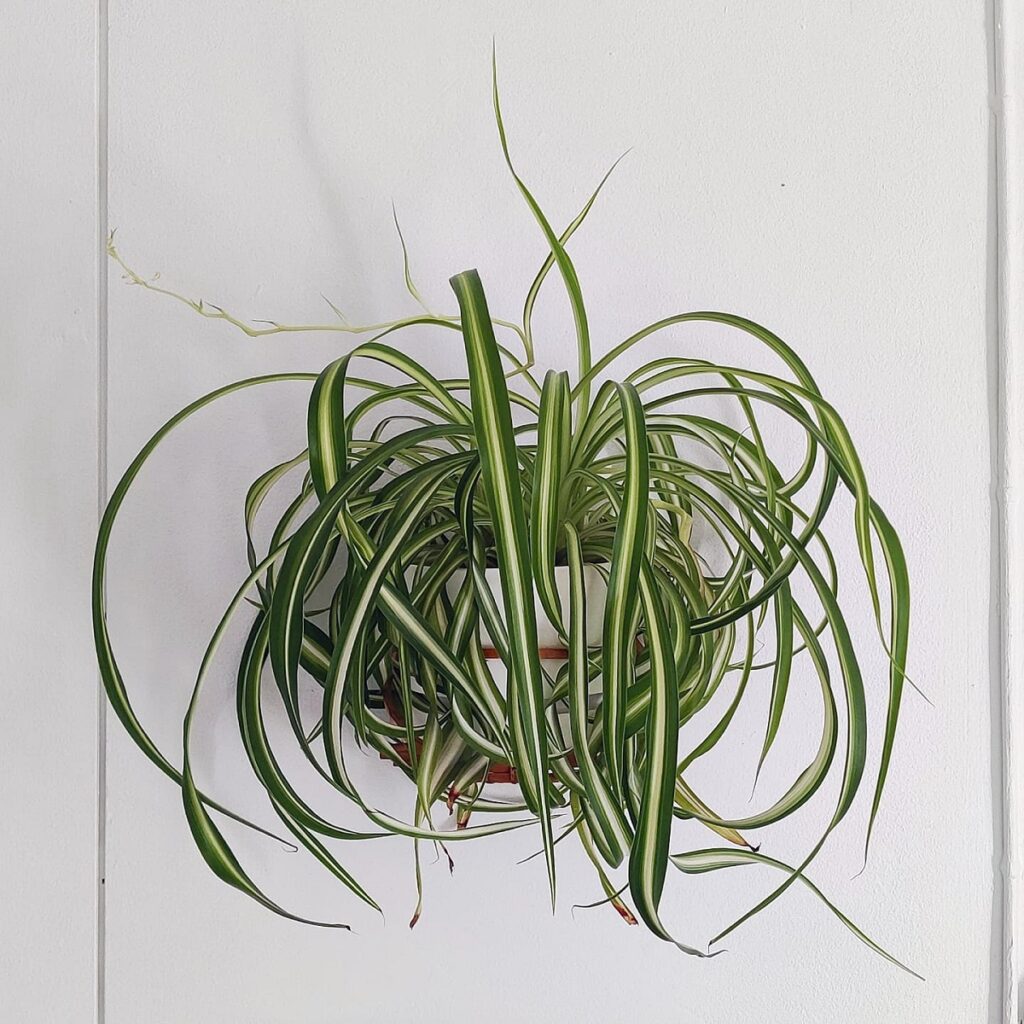
You’ll love the uniquely attractive twirled leaves of the Bonnie Spider Plant! This air-purifying plant is scientifically known as Chlorophytum comosum ‘Bonnie’. The Bonnie Spider Plant has long, green, and creamy white edges. It can grow up to 8 – 18 inches and prefers bright, indirect light or artificial light. Water this plant only when it’s dry to keep it healthy. Fertilize your Bonnie Spider Plant every two weeks for optimal health and growth.
To propagate a new Bonnie Spider Plant, break off a leaf with roots attached to your existing one and place it in the soil. Caring for the Bonnie Spider Plant is easy; just make sure you give it adequate water and light when needed. Hang it in a basket or pot so you can enjoy its beauty all year round!
Airplane Spider Plant

The Airplane Spider Plant has light green leaves with yellowish margins, making it a great choice for adding some color to your home. It grows almost 2-3 ft high and is a perennial plant. This type of spider plant is relatively easy to care for and needs only partial direct sunlight to thrive. It also requires well-draining soil and airflow effects to help keep its roots moist. Its white fleshy roots are able to survive in dry weather as well so you don’t have to worry about watering it too often. As an extra bonus, this type of spider plant rarely flowers, making it perfect for those who prefer an ornamental look without the hassle of blooms or pollen.
Hawaiian Spider Plant

The Hawaiian Spider Plant is a unique and eye-catching houseplant with distinctly variegated patterns on its young leaves. It grows 18 to 24 inches tall and spreads 12 to 18 inches wide, making it ideal for brightening up any space. The young leaves of the plant are bright white, cream and light green in color, but as they age, the variegation darkens to a deep green shade. Growing this plant requires plenty of bright light and frequent watering for successful growth.
In addition to its beauty, there are many benefits of owning a Hawaiian Spider Plant. It is known for being hardy and easy to care for while also providing air purification by removing toxins from the environment. As an added bonus, it can help reduce stress levels due to its calming effect on people.
Although the Hawaiian Spider Plant is generally low maintenance, common problems may arise if not given proper care such as improper lighting or too much water leading to root rot or pest infestations which can put your plant at risk. Properly caring for your Hawaiian Spider Plant will ensure that you enjoy its beauty and benefits without any additional hassle!
Fire Flash Spider Plant

Experience the vibrant beauty of the Fire Flash Spider Plant, with its unique orange foliage and evergreen leaves! This tropical perennial is an easy-care plant that can brighten up any home. Its broad ovate-lanceolate leaves are a stunning green color that will add a touch of drama to your space.
When it comes to caring for your Fire Flash Spider Plant, there are a few key requirements and growing tips to keep in mind. It prefers partial shade and moist soil, so make sure you’re not over-watering or exposing it to too much direct sunlight. To ensure healthy growth, fertilize once every two weeks during its growing season. Additionally, prune away any dead or diseased foliage as needed for optimal growth.
Reverse Spider Plant
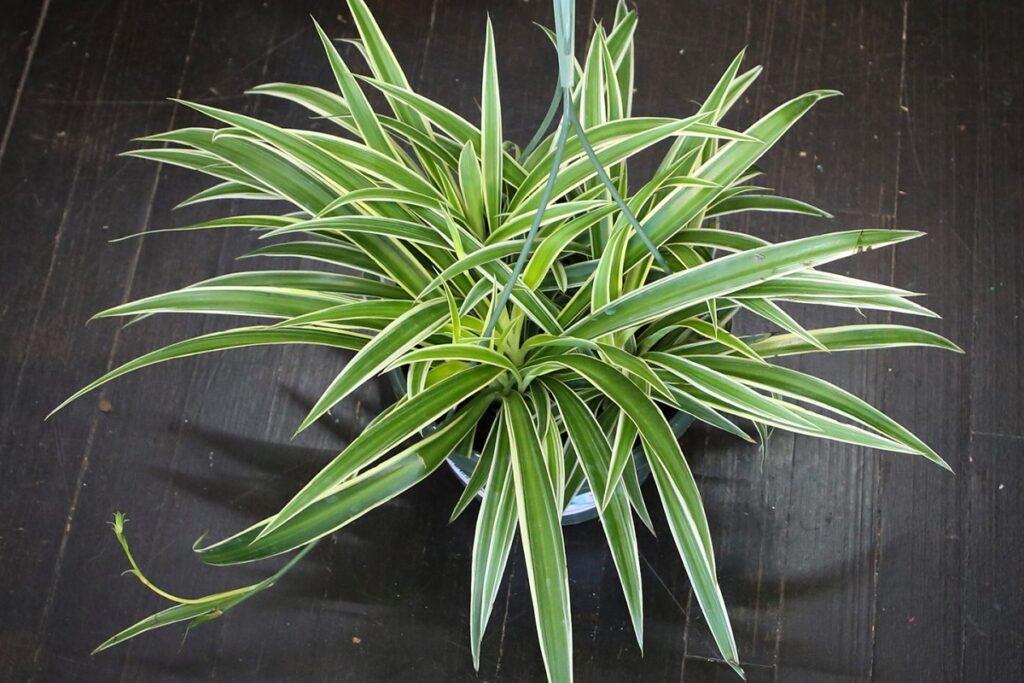
Reverse Spider Plant is a stunning tropical perennial with vibrant white-margined green leaves that make a dramatic statement in any home. This plant can grow up to two feet tall and three feet wide, so it’s important to prune it regularly for the best shape. It requires some direct light or bright light for optimum growth and needs regular reverse fertilizing. When choosing soil, be sure it is well-draining with some organic matter mixed in.
Green Spider Plant
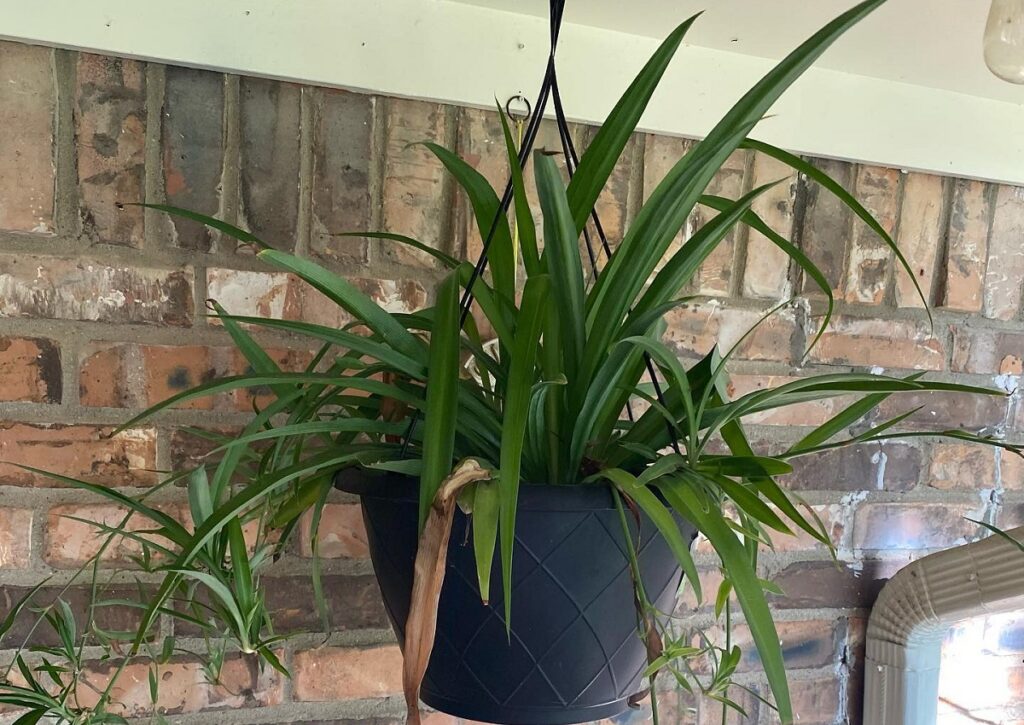
You’ll be amazed by the lush green foliage of the Chlorophytum comosum or Green Spider Plant! This rare collection of spider plants is notable for its dark green leaves with no creamy or light yellow stripes. After 1970, production was discontinued but you can still multiply this plant through propagation. It’s important to properly care for your Green Spider Plant; make sure you have adequate space and lighting as well as a proper watering schedule. Additionally, watch out for pests that could harm your plant such as aphids and mealybugs.
Ocean Spider Plant
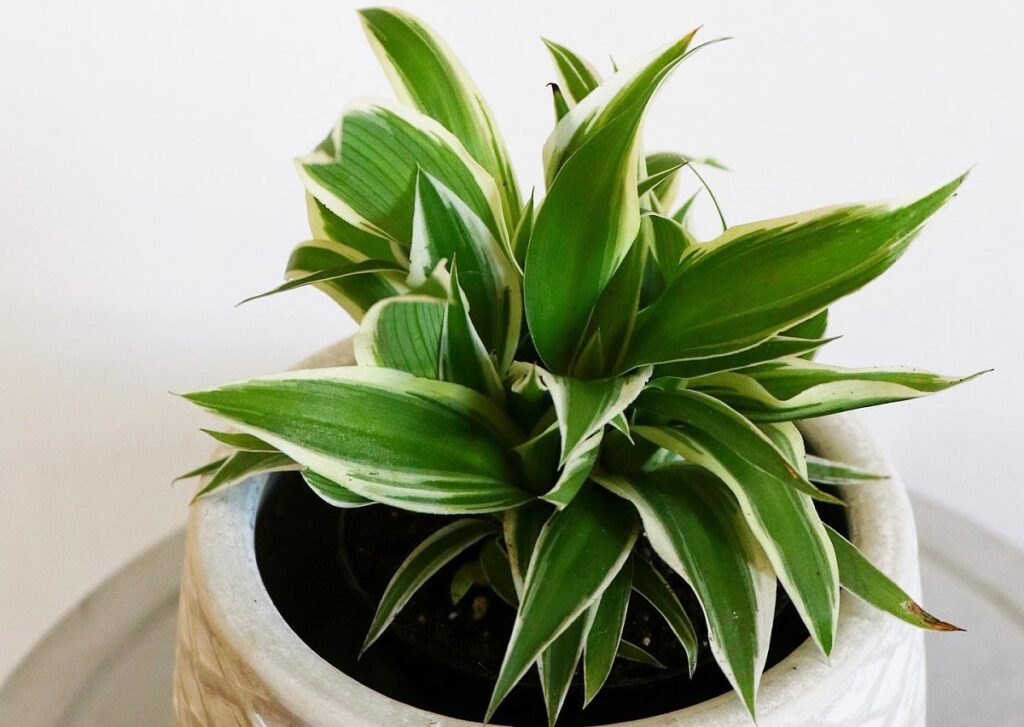
Another type of spider plant is the Ocean Spider Plant. Its leaves have a green core surrounded by a creamy white margin. Tiny white flowers appear on its stems, which are narrow and long. When fully grown, the Ocean Spider Plant is around 18 inches tall and 12 inches wide. To keep it happy, it needs bright indirect light, well-drained soil, and regular watering. It looks beautiful in a hanging basket too!
Variegated Spider Plant

The Variegated Spider Plant is a beautiful perennial with narrow green leaves striped with creamy white. It can be an attractive addition to any home as it is drought-tolerant and easy to grow. To help ensure your variegated spider plant’s success, you should take care when choosing the right environment for it. Improving its growth starts by identifying suitable care, such as access to bright filtered light, frequent watering, and appropriate temperatures. Cultivating different varieties of variegated spider plants may also help create a more interesting look since they come in many forms, including hanging pots and small starry panicles.
Zebra Spider Plant
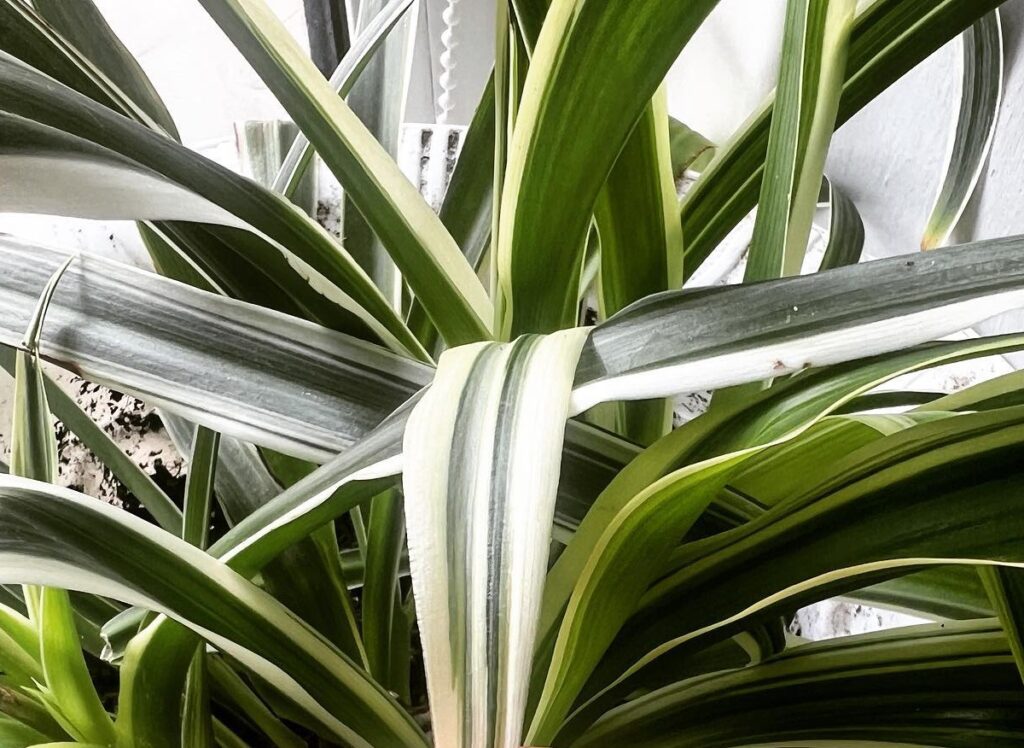
Zebra Spider Plant is a unique variety of Chlorophytum laxum, with bright yellow leaf margins and green centers. It’s an attractive hanging plant that will add life to any space. Although Zebra Spider Plant is not as tall as some other varieties, it spreads farther out horizontally. To propagate this type of spider plant, you can use division or cuttings from existing plants. When caring for your Zebra Spider Plant, be sure to inspect for pests regularly and take appropriate steps if necessary to control them.
Variegated Bonnie Spider Plant
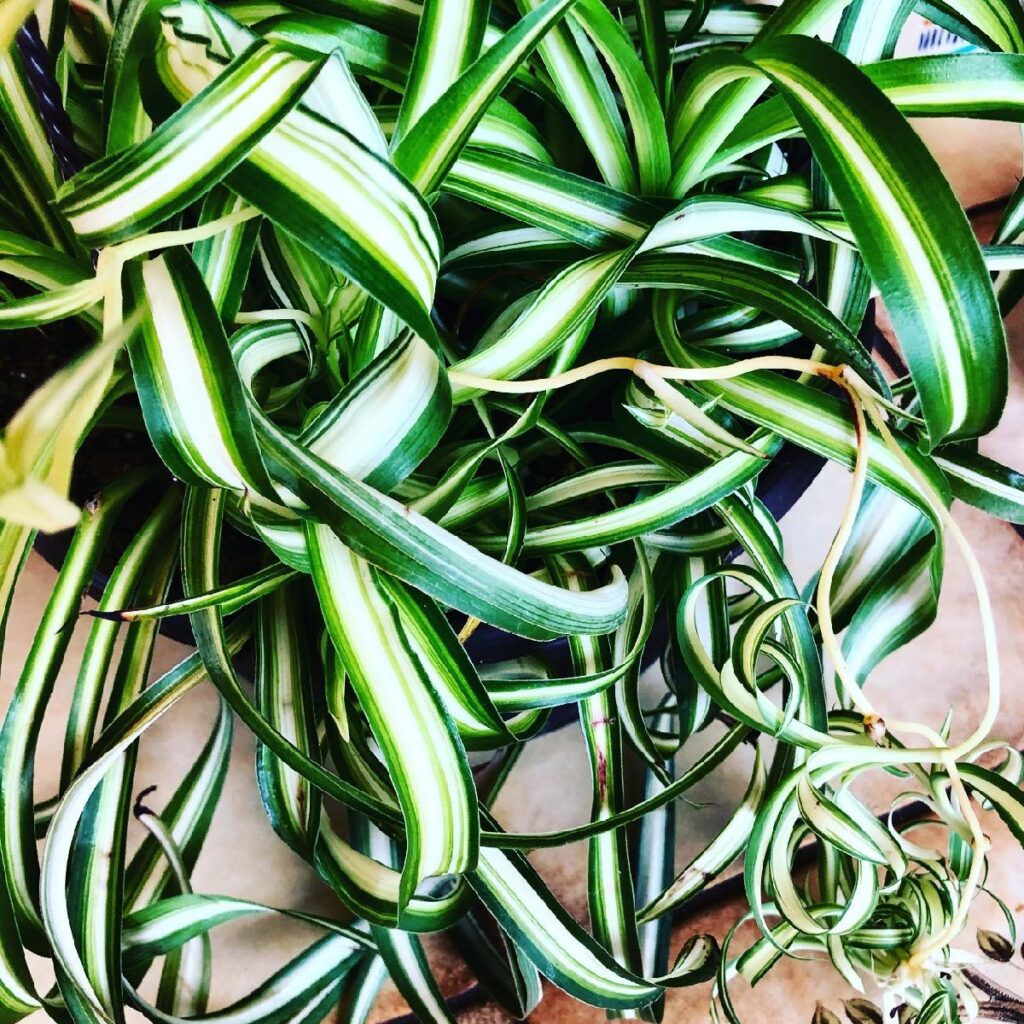
Chlorophytum comosum ‘Bonnie Variegated’ is an attractive, fast-growing plant with green leaves and creamy white stripes. This plant can be easily grown indoors or outdoors in a hanging basket for added visual interest. It is also known as the Zebra Spider Plant and is a great choice for those looking to add an eye-catching element to their home. Variegated Bonnie Cultivation requires warm temperatures between 65°F – 75°F, bright indirect sunlight, and well-draining soil.
When it comes to Variegated Bonnie Care, you should water it regularly but avoid over-watering as this can cause root rot. Additionally, you should fertilize it every few months during its active growth period with a balanced liquid fertilizer. To propagate Variegated Bonnie Spider Plants, remove the offsets from the parent plant when they are 4 inches tall and pot them up separately in moist potting soil.
Bichetii Grass Spider Plant

Continuing with our exploration of spider plants, let’s take a look at the Bichetii Grass Spider Plant. This unique variety has light green leaves with white or cream margins that are smaller than what you would find on a Variegated Bonnie plant. It produces small white flowers but unfortunately will not produce any baby plants like its Variegated counterpart.
When caring for your Bichetii Grass Spider Plant, it’s important to pay attention to potting tips and proper propagation methods in order to keep it healthy and happy. Make sure that the soil is well drained and that you water when the soil is dry to avoid root rot. You can fertilize during the growing season if desired for an extra boost of nutrition.
Atlantic Spider Plant
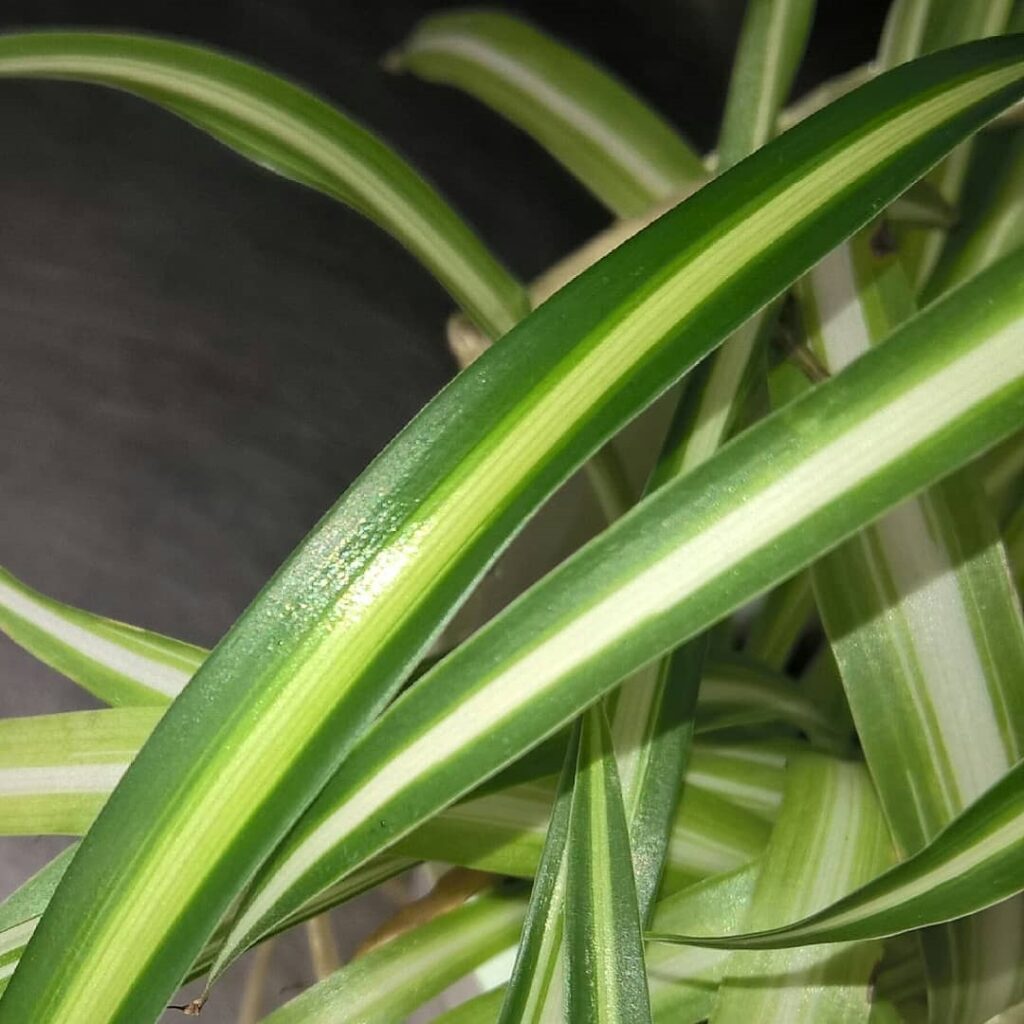
The Atlantic Spider Plant is an attractive species with white ribboned foliage and a green margin. Native to South Africa and Asia, this air-purifying spider plant can grow up to 25-50 cm and spread 10-25cm. It’s easy to cultivate and propagate in bright light or shade, as well as moist soil. Plus, it looks great as a hanging plant! For the best care, make sure you understand how to properly water your Atlantic Spider Plant. Be sure not to overwater it; instead wait until the topsoil is slightly dry before giving your plant a drink.
Purple Spider Plant
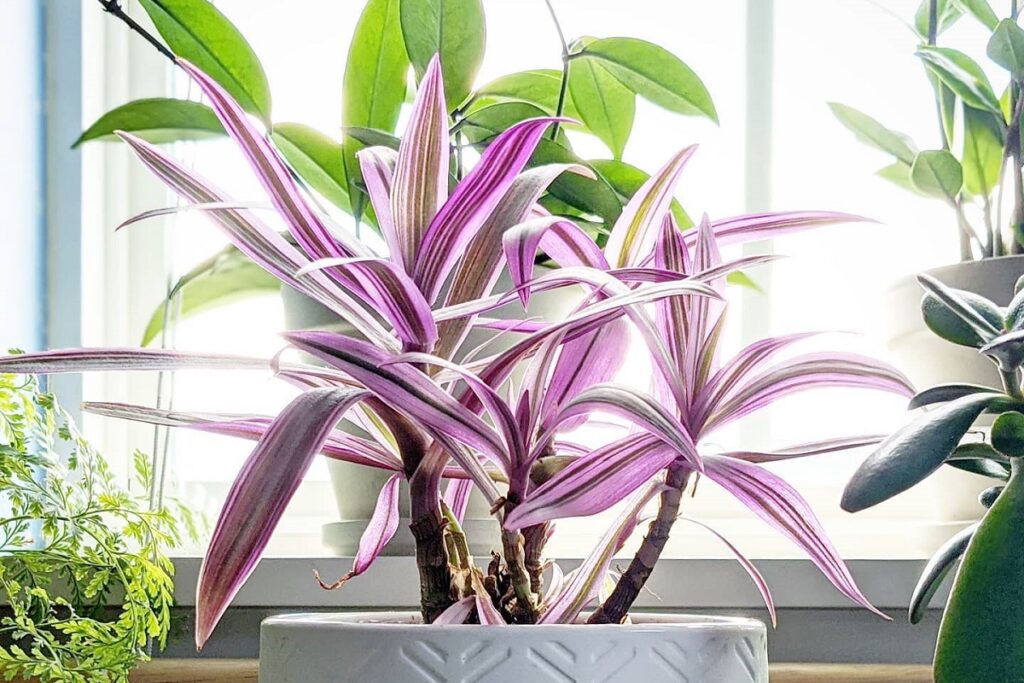
You’ll love the vibrant violet flowers of the Purple Spider Plant! This fast-growing annual plant is a great addition to any garden. It grows up to 3-4 feet tall and spreads 1-2 feet wide. To keep your Purple Spider Plant healthy and blooming, it requires full sun, well-drained soil, and average watering. Be sure you are providing all these needs so that your plant can thrive!
Shamrock Spider Plant
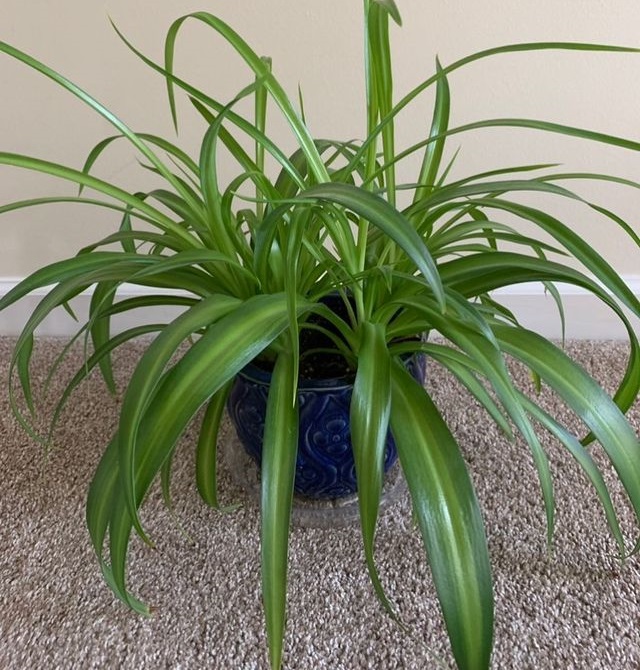
Shamrock Spider Plant is a rare variety of spider plant cultivars, boasting green leaves with creamy edges and star-shaped white flowers. It can be grown both indoors and outdoors but thrives best when outside in the sun. To ensure maximum growth and blooms, proper shamrock care should be taken to keep it well-watered and adequately fertilized.
The runners from the main plant are ideal for propagation, making this species easy to spread throughout your garden or home. There are other variations of this spider plant that have different flower colors or leaf shapes, offering more options for decorating your space with nature’s beauty.
Mandarin Orange Spider Plant

Brighten up your home or garden with the vibrant Mandarin Orange Spider Plant! This cheerful plant has shiny green leaves and colorful orange stems, making it an attractive addition to any space. Its low maintenance care needs include bright indirect light and partial shade but keep it away from direct sunlight. To ensure that your mandarin orange is healthy, give it regular waterings and pest management when necessary. Growing tips for this unique spider plant include ensuring that the soil is well-draining and fertilizing every few weeks. Add a splash of color to your living space with the stunning Mandarin Orange Spider Plant!
Curly Spider Plant
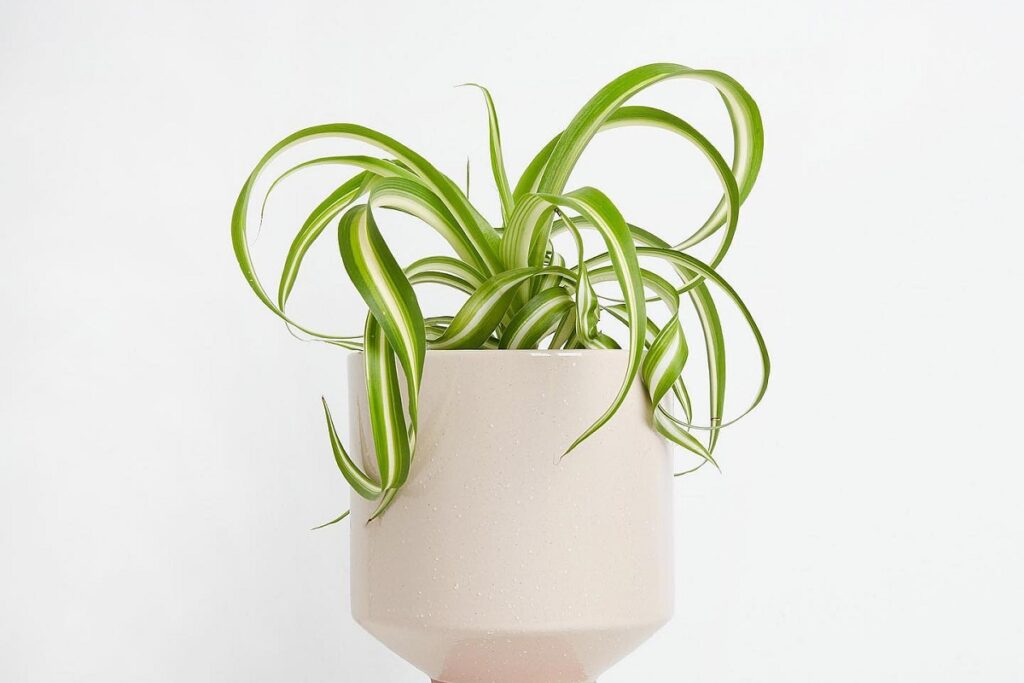
After learning about the Mandarin Orange Spider Plant, let’s now explore another type of spider plant: the Curly Spider Plant. This plant is native to tropical and Southern Africa, and is characterized by its dark green leaves with white stripes in the midpoint. Its leaves are twisted and broad enough to give a unique appeal to garden lovers. In springtime, small white flowers bloom from this perennial plant. Curly Spider Plants can be grown indoors in pots or wall corners, adding life to any space you have.
When caring for your Curly Spider Plant, make sure it gets bright indirect sunlight and water when the soil is dry. Additionally, propagating these plants is easy – just snip off a few leafy sections and either replant them directly or place them in water until roots form before transplanting. Finally, watch out for common diseases as they can quickly affect your curly spider plant.
Chlorophytum Spider Plant
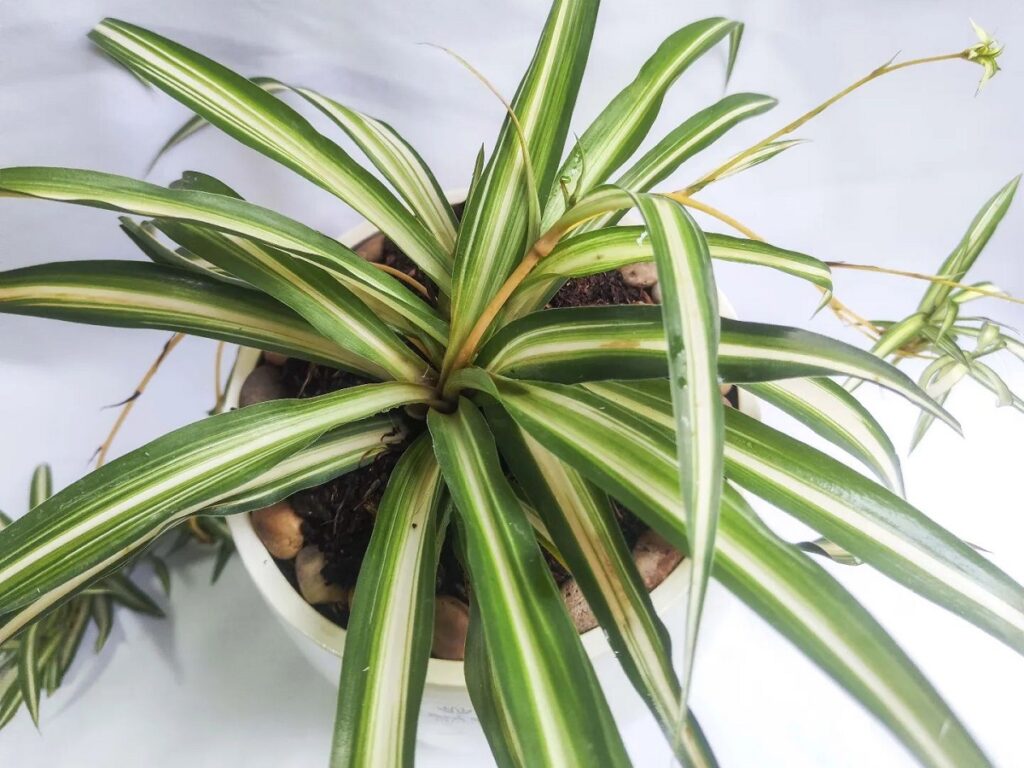
The Chlorophytum Spider Plant is a unique and eye-catching perennial that adds color and texture to the home or garden. It is very similar to Chlorophytum comosum but has narrow, sharp leaves that are solid green in color. The white flowers it produces are mostly star-shaped and it can grow up to 1 foot tall with a spread of 2 feet. To ensure healthy growth, it needs partial sunlight or full sun. Fertilizing chlorophytum can help promote steady growth, harvesting chlorophytum should be done carefully, and propagating chlorophytum by separating its shoots helps keep your plant looking beautiful for years.
Vittatum Spider Plant
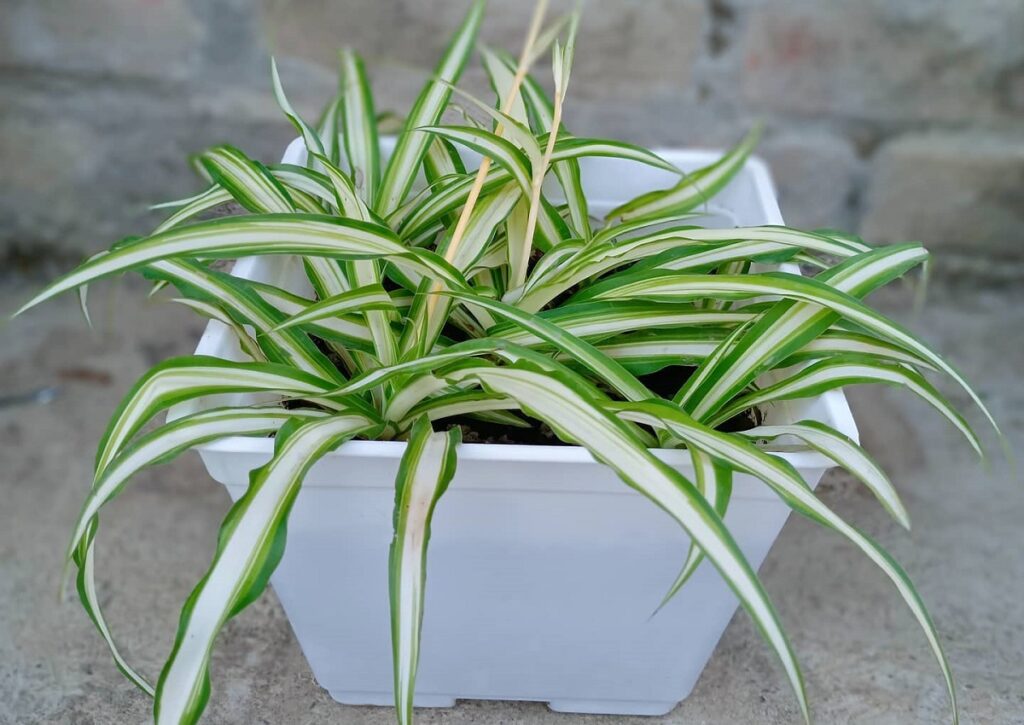
Vittatum Spider Plant is an eye-catching perennial with narrow, sharp leaves that have a green base and white stripes in the center. This attractive plant can grow up to 12 to 24 inches tall and spread out just as much. It prefers bright indirect sunlight and well-draining soil. To keep your Vittatum looking its best, fertilize it once every two weeks during its active growing season and water when the soil is dry to ensure it has enough moisture.
Propagation of these plants can be done through division or using its offshoots which are produced at the end of long stems from the mother plant. When caring for this spider plant, ensure that temperatures remain between 65°F-80°F (18°C-26°C) as higher temperatures can cause leaf burn or discoloration.
Spider Flower Plant
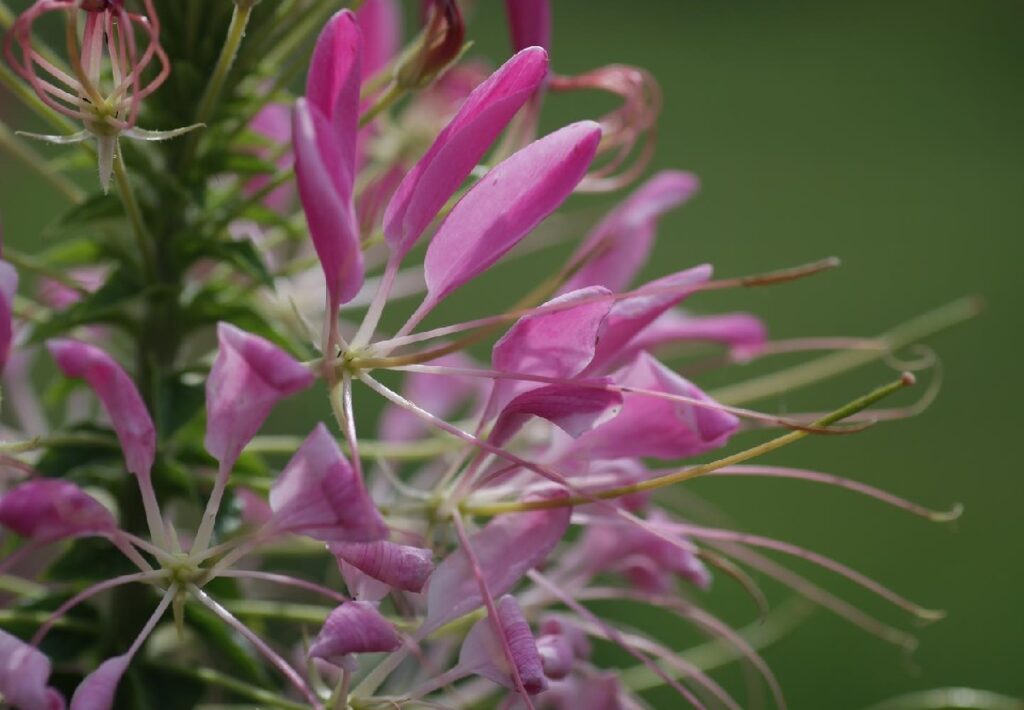
Transitioning to the Spider Flower Plant, a unique species of Cleome Hassleriana, this flowering plant is perfect for anyone looking for vibrant colors and pest protection. Easily propagated through hybridizing techniques and simple propagation methods, this plant will give your garden lots of character. With its five to seven leaflets per pinnately complex leaf measuring up to five inches in length and two inches in width, the Spider Flower Plant will provide an interesting contrast with its bright pink color. Its natural habitats extend from South America’s Southeast Brazil, Argentina, Paraguay, and Uruguay regions. Not only does it look beautiful but it can also help protect your garden from pests.
Conclusion
Spider plants come in a variety of shapes and sizes, from the Bonnie Plant to the Spider Flower Plant. They’re easy-care houseplants that can thrive in many different environments, making them a great choice for any home or office. Whether you’re looking for a small plant to brighten up your desk or something more eye-catching for your living room, there’s sure to be a spider plant that fits your needs. So why not give one of these 19 types of spider plants a try today? You won’t regret it!
